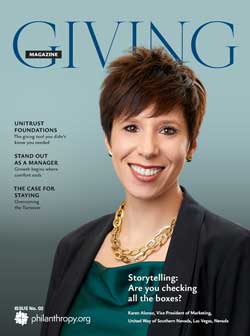Why not begin the New Year with a fresh, new approach to cultivating and stewarding planned giving donors?
Too often, once a prospect has documented his/her bequest intentions, the donor acknowledgment period lasts through several months of standard thank-you letters, a holiday greeting or goodie, and perhaps a recognition dinner (depending on level of gift).
The donor’s name is summarily noted in recognition reports, on walls of fame, etched onto a plaque or mug, and whisked away into a legacy giving society.
Then, it drops off the crevice into the deep, dark hole of “no further action required.”
Does Your Donor Hate You?
Fast forward to a recent Mid-American Development Conference. We’re listening to a panel presentation by donors with complaints about how nonprofits had treated them. One of them said:
I was virtually forgotten... tucked away in someone’s file. I wasn’t on anyone’s invitation list, never received a call, never even got a simple birthday card…
Donor Tweet
The audience was stunned by how this lady donor’s multi-million dollar bequest went largely ignored. But she had more to say:
“So when I updated my Trust, I took them out. They probably still don’t realize, but when I pass, they’ll discover what I did, and it will be far too late for anyone to make amends.”
Here was a donor who simply wished to be remembered and engaged on an ongoing basis. Instead she was tossed into a drawer and forgotten. But she had the last word – and that word was “payback.”
And rightly so. There’s no excuse for treating a donor like that. So let’s review our current practices to find more creative and effective ways to maintain those crucial donor relationships.
Real Stewardship
It requires way more than just gift acknowledgement. For example, what if your donor learns that her estate gift will either not be used as intended or has not been approved by the benefiting program? Naturally, she’s going to revoke the gift and find another organization more deserving of her philanthropy.
So crafting appropriate gift agreements that substantiate the gift and how it will be utilized is more than just good practice. It’s simply essential.
High-Yield Cultivation
As development professionals, we prioritize our pool of prospects and maximize the activity spent to ask for and secure gifts. As planned giving officers, we must also build in the appropriate process to provide ongoing cultivation of our revocable planned gift donors.
For small shops, this focus can be easily achieved by instituting new policies to replace outmoded or ineffective ones; for larger programs, a team can be put into place to “do the thank” and do it well.
Principles of Best Behavior for Bequests
- A revocable gift is just that… revocable. It comes with its own caveat emptor: I have given, yet I can take away… never forget!
- Every planned giving donor belongs in the current donor file, if only to be “touched” as frequently as donors of gift annuities, or outright gifts.
- Donors of bequests don’t get annual updates on their endowment performance or how you have utilized their gift; so create a way to communicate with them on a regular basis providing this information (and don’t forget to say “thank you” again!).
- Donors of bequests are excellent prospects for other gifts, especially current and annual. As you keep them engaged and looking forward to how their legacy will be preserved, you can interest them in experiencing their donor satisfaction during their lifetime as well.
- Holiday greetings are a must, as would be special birthdays or other special occasions. But why stop with a greeting? Invite them to join advisory groups, special committees, or accompany you on calls to other planned giving prospects.
- In every communication, be sure to mention the legacy society as the firm foundation of the future, and acknowledge the importance and generosity of the donors who have made the ultimate gift.
- Provide donors with a proactive, heartfelt reminder of your organization and its gratitude to them.
- And finally, become a better listener. It will make you a better fundraiser.
Don’t think of a planned gift as the donor’s last gift ... think of it as a deepening and intensifying of their relationship with your institution. Commit now to keeping up your own end of that relationship. And remember: an intention to leave a legacy is confirmation of the donor’s passion. Treat every intention as a promise... for you to keep the donor up front, and the passion ongoing.
Mindy Tweet


